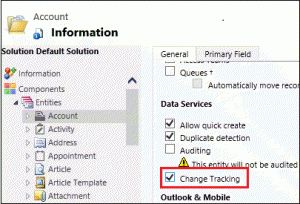Blog
What’s New for Developers in Microsoft Dynamics CRM 2015 Update 1 – Data Synchronization
We love to customize Microsoft Dynamics CRM solutions here at Beringer. We’ve been working with Microsoft Dynamics CRM since its inception, and we’re always finding innovative ways to implement the latest tools and help automate business processes. If you are looking for a certified Microsoft solution partner to help you with your CRM installation, make sure you pick the one that keeps in sync with all of the latest technologies.
There’s quite a few new enhancements and capabilities in the Microsoft Dynamics 2015 Update 1 release, including some great new tools for developers. Microsoft has included several new features that makes it easier to integrate and synchronize CRM data with external data sources.
You can greatly improve efficiency of code that monitors changes to CRM data by using the RetrieveEntityChangesRequest message included in this release. The new Change Tracking feature provides a way to keep the CRM data stored in an external data source, synchronized in a performant way by detecting what data has changed since the data was initially extracted or last synchronized.
How does it work? First, you need to enable Change Tracking on an entity level basis.

When Change Tracking is enabled for an entity, you can use the RetrieveEntityChangesRequest message to retrieve the changes for that entity. The first time this message is used it returns all records for the entity and that data can be used to populate the external storage. The message also returns a version number that will be sent back with the next use of the RetrieveEntityChangesRequest message so that only data for those changes that occurred since that version will be returned.
How does the code work? The code is very similar to the RetrieveEntityRequest Class:

The response will return a data token, which represents a point in time snapshot of the data.
You can now include this token in your next RetrieveEntityChangesRequest, and retrieve just the change set since your last request.
How will you use this code in your next integration? Feel free to play with the sample code and post your ideas here. You can check out all of the new developer features by clicking here.
Can we help you with your CRM implementation? Please feel free to contact Beringer, a Microsoft Gold Certified Partner.




